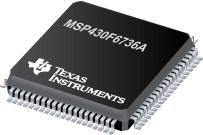●The Texas Instruments MSP430 family of ultra-low-power microcontrollers consists of several devices featuring different sets of peripherals targeted for various applications. The architecture, combined with extensive low-power modes, is optimized to achieve extended battery life in portable measurement applications. The device features a powerful 16-bit RISC CPU, 16-bit registers, and constant generators that contribute to maximum code efficiency. The digitally controlled oscillator (DCO) allows the device to wake up from low-power modes to active mode in 3 µs (typical).
●The MSP430F673xA and MSP430F672xA devices are microcontrollers with three high-performance 24-bit sigma-delta ADCs, a 10-bit ADC, four eUSCIs (three eUSCI_A modules and one eUSCI_B module), four 16-bit timers, a hardware multiplier, a DMA module, an RTC module with alarm capabilities, an LCD driver with integrated contrast control, an auxiliary supply system, and up to 72 I/O pins in the 100‑pin devices and 52 I/O pins in the 80‑pin devices.
● Low Supply-Voltage Range: 3.6 V Down to 1.8 V
● Ultra-Low Power Consumption
● Active Mode (AM):
●All System Clocks Active
●265 µA/MHz at 8 MHz, 3.0 V, Flash Program Execution (Typical)
●140 µA/MHz at 8 MHz, 3.0 V, RAM Program Execution (Typical)
● Standby Mode (LPM3):
●Real-Time Clock (RTC) With Crystal, Watchdog, and Supply Supervisor Operational, Full RAM Retention, Fast Wakeup:
●1.7 µA at 2.2 V, 2.5 µA at 3.0 V (Typical)
● Off Mode (LPM4):
●Full RAM Retention, Supply Supervisor Operational, Fast Wakeup:
●1.6 µA at 3.0 V (Typical)
● Shutdown RTC Mode (LPM3.5):
●Shutdown Mode, Active RTC With Crystal:
●1.24 µA at 3.0 V (Typical)
● Shutdown Mode (LPM4.5):
●0.78 µA at 3.0 V (Typical)
● Wakeup From Standby Mode in 3 µs (Typical)
● 16-Bit RISC Architecture, Extended Memory, up to 25-MHz System Clock
● Flexible Power Management System
● Fully Integrated LDO With Programmable Regulated Core Supply Voltage
● Supply Voltage Supervision, Monitoring, and Brownout
● System Operation From up to Two Auxiliary Power Supplies
● Unified Clock System
● FLL Control Loop for Frequency Stabilization
● Low-Power Low-Frequency Internal Clock Source (VLO)
● Low-Frequency Trimmed Internal Reference Source (REFO)
● 32-kHz Crystals (XT1)
● One 16-Bit Timer With Three Capture/Compare Registers
● Three 16-Bit Timers With Two Capture/Compare Registers Each
● Enhanced Universal Serial Communication Interfaces (eUSCIs)
● eUSCI_A0, eUSCI_A1, and eUSCI_A2
● Enhanced UART Supports Automatic Baud-Rate Detection
● IrDA Encoder and Decoder
● Synchronous SPI
● eUSCI_B0
● I2C With Multiple Slave Addressing
● Synchronous SPI
● Password-Protected RTC With Crystal Offset Calibration and Temperature Compensation
● Separate Voltage Supply for Backup Subsystem
● 32-kHz Low-Frequency Oscillator (XT1)
● Real-Time Clock
● Backup Memory (4 × 16 Bits)
● Three 24-Bit Sigma-Delta Analog-to-Digital Converters (ADCs) With Differential PGA Inputs
● Integrated LCD Driver With Contrast Control for up to 320 Segments in 8-Mux Mode
● Hardware Multiplier Supports 32-Bit Operations
● 10-Bit 200-ksps ADC
● Internal Reference
● Sample-and-Hold, Autoscan Feature
● Up to Six External Channels and Two Internal Channels, Including Temperature Sensor
● Three-Channel Internal DMA
● Serial Onboard Programming, No External Programming Voltage Needed
● Available in 100-Pin and 80-Pin LQFP Packages



